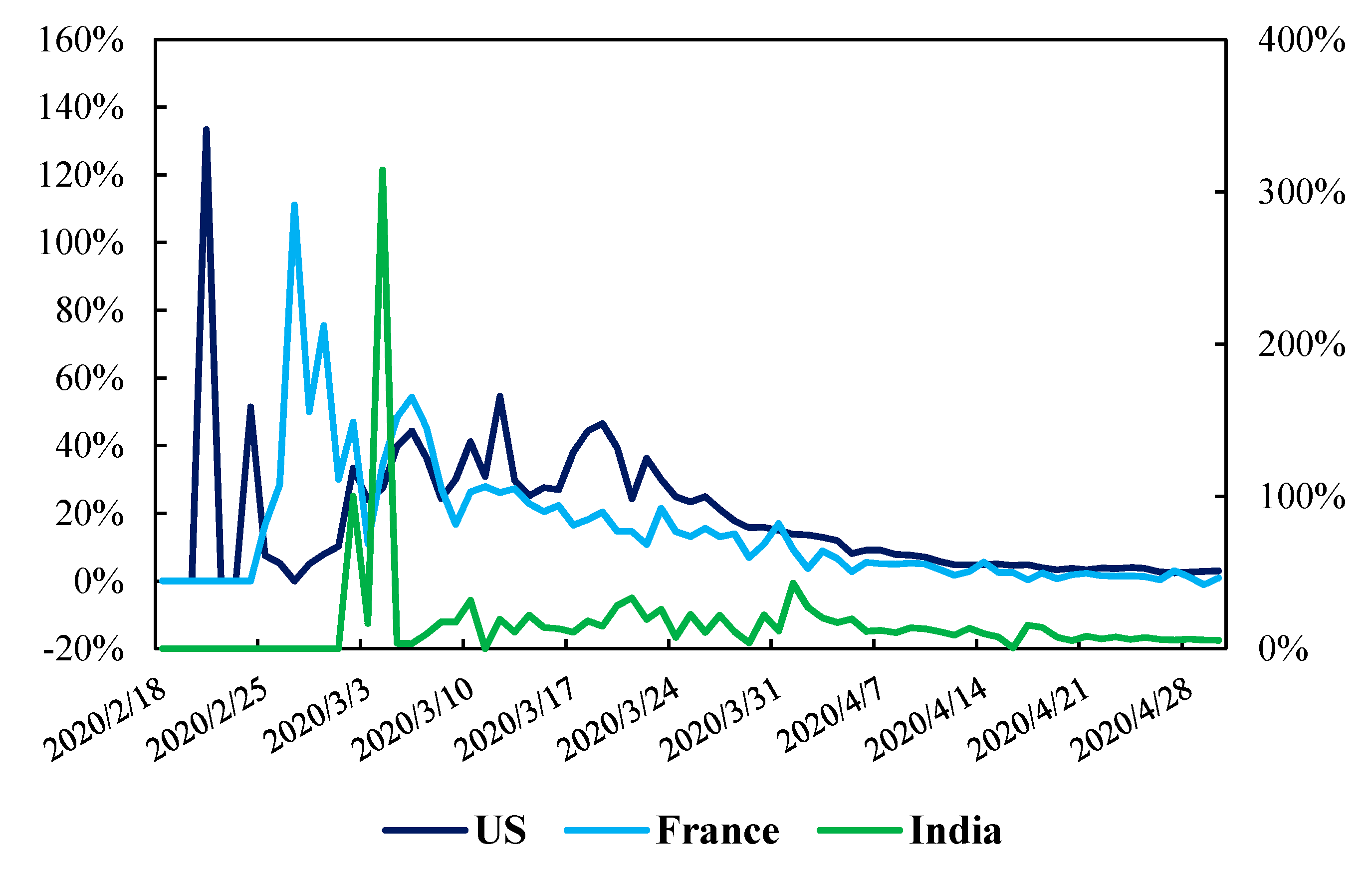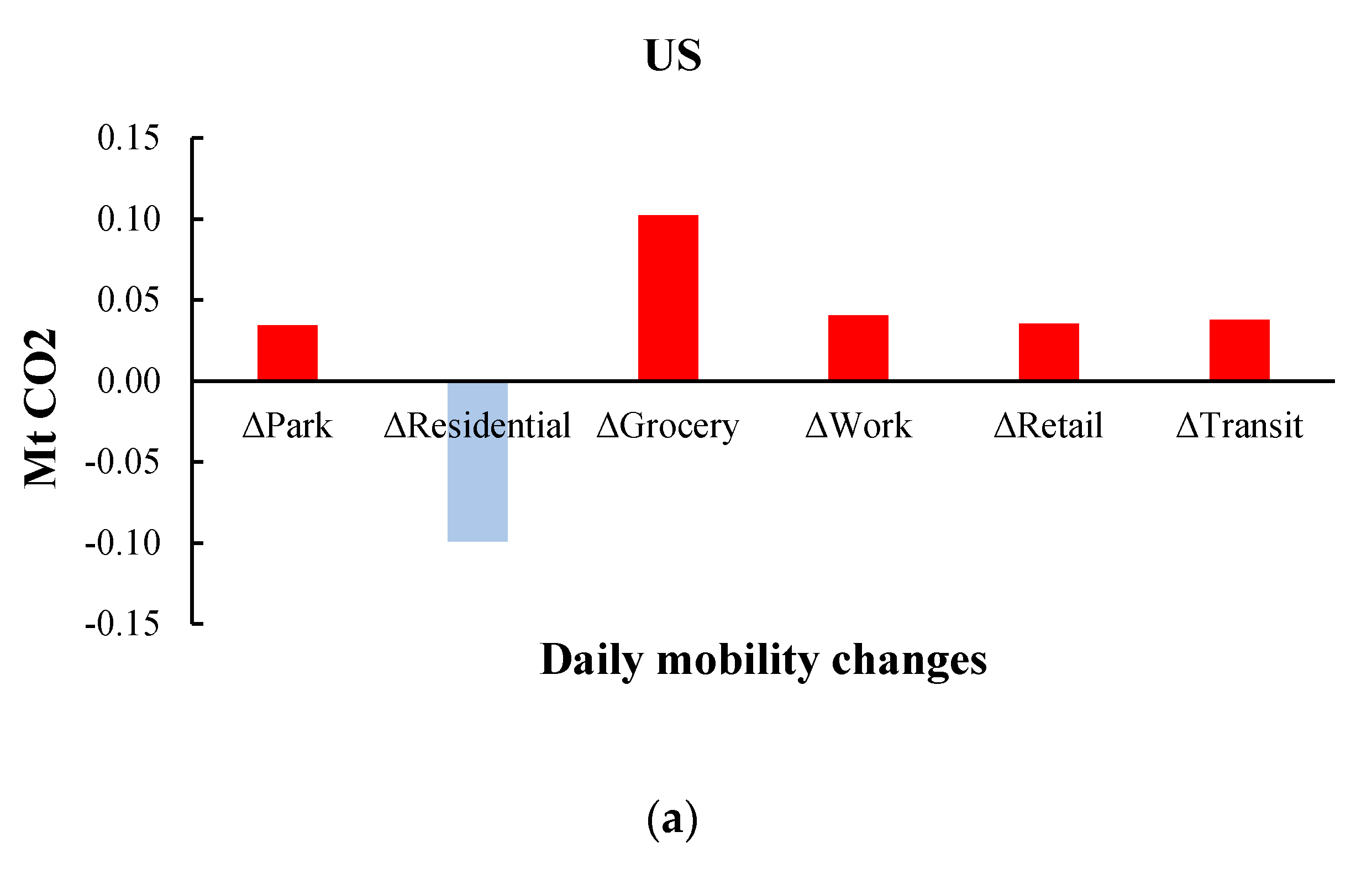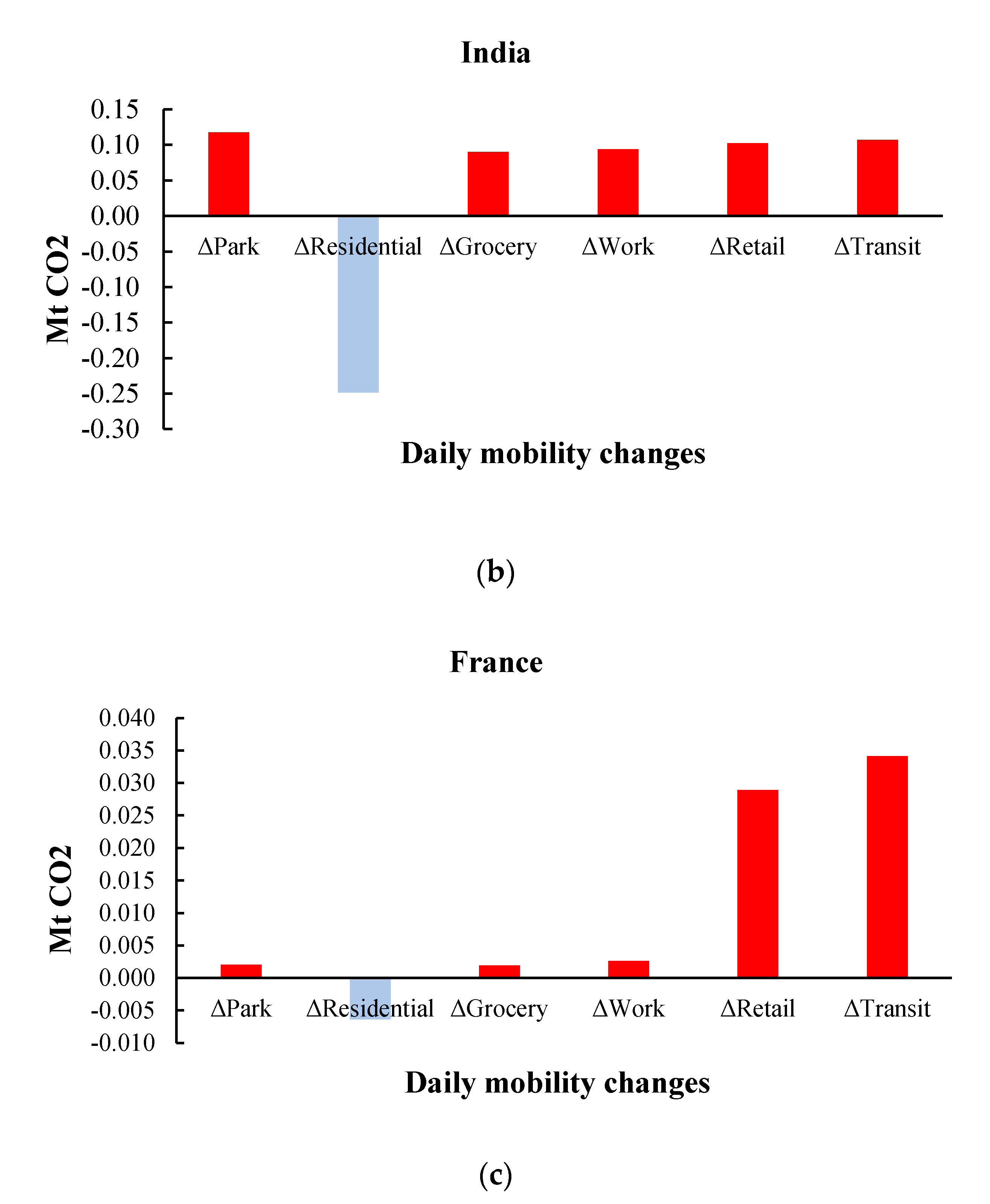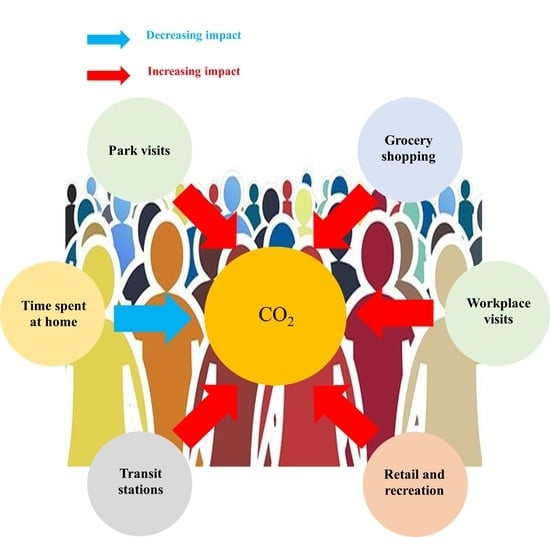Does Staying at Home during the COVID-19 Pandemic Help Reduce CO2 Emissions?
Abstract
:1. Introduction
2. CO2 Emissions and Changes in Human Mobility during the COVID-19 First Wave
3. Materials and Methods
4. Results
4.1. Linear ARDL Bounds Test for Cointegration
4.2. Staying Home Is Cutting Down CO2 Emissions
4.3. Parks, Groceries, and Workplace Visits Contributing to CO2 Emissions
4.4. Retail & Recreation and Transport Station Mobility Contributing to CO2 Emissions
4.5. Practical Implications
5. Conclusions
Supplementary Materials
Author Contributions
Funding
Institutional Review Board Statement
Informed Consent Statement
Data Availability Statement
Acknowledgments
Conflicts of Interest
References
- IPCC. Climate Change 2014: Synthesis Report; IPCC: Geneva, Switzerland, 2014. [Google Scholar]
- Beth, G. Why COVID-19 Will End Up Harming the Environment (National Geography). National Geography. 19 June 2020. Available online: https://www.nationalgeographic.com/science/article/why-covid-19-will-end-up-harming-the-environment (accessed on 13 April 2021).
- Le Quéré, C.; Jackson, R.B.; Jones, M.W.; Smith, A.; Abernethy, S.; Andrew, R.M.; De-Gol, A.J.; Willis, D.R.; Shan, Y.; Canadell, J.G.; et al. Temporary reduction in daily global CO2 emissions during the COVID-19 forced confinement. Nat. Clim. Chang. 2020, 10, 647–653. [Google Scholar] [CrossRef]
- NASA Satellite Data Show 30 Percent Drop in Air Pollution Over Northeast U.S. NASA Air Quality Analysis. 2020. Available online: https://airquality.gsfc.nasa.gov/ (accessed on 16 April 2021).
- Hadjidemetriou, G.M.; Sasidharan, M.; Kouyialis, G.; Parlikad, A.K. The impact of government measures and human mobility trend on COVID-19 related deaths in the UK. Transp. Res. Interdiscip. Perspect. 2020, 6, 100167. [Google Scholar] [CrossRef]
- Hoque, A.; Shikha, F.A.; Hasanat, M.W.; Arif, I.; Hamid, A.B.A. The effect of Coronavirus (COVID-19) in the tourism industry in China. Asian J. Multidiscip. Stud. 2020, 3, 52–58. [Google Scholar]
- Kaushal, V.; Srivastava, S. Hospitality and tourism industry amid COVID-19 pandemic: Perspectives on challenges and learnings from India. Int. J. Hosp. Manag. 2021, 92, 102707. [Google Scholar] [CrossRef] [PubMed]
- Gössling, S.; Scott, D.; Hall, C.M. Pandemics, tourism and global change: A rapid assessment of COVID-19. J. Sustain. Tour. 2020, 29, 1–20. [Google Scholar] [CrossRef]
- Aruga, K. Changes in Human Mobility under the COVID-19 Pandemic and the Tokyo Fuel Market. J. Risk Financ. Manag. 2021, 14, 163. [Google Scholar] [CrossRef]
- Zambrano-Monserrate, M.A.; Ruano, M.A.; Sanchez-Alcalde, L. Indirect effects of COVID-19 on the environment. Sci. Total Environ. 2020, 728, 138813. [Google Scholar] [CrossRef] [PubMed]
- Liu, Z.; Ciais, P.; Deng, Z.; Lei, R.; Davis, S.J.; Feng, S.; Zheng, B.; Cui, D.; Dou, X.; Zhu, B.; et al. Near-real-time monitoring of global CO2 emissions reveals the effects of the COVID-19 pandemic. Nat. Commun. 2020, 11, 1–12. [Google Scholar] [CrossRef]
- Muhammad, S.; Long, X.; Salman, M. COVID-19 pandemic and environmental pollution: A blessing in disguise? Sci. Total Environ. 2020, 728, 138820. [Google Scholar] [CrossRef]
- Fan, C.; Li, Y.; Guang, J.; Li, Z.; Elnashar, A.; Allam, M.; De Leeuw, G. The Impact of the Control Measures during the COVID-19 Outbreak on Air Pollution in China. Remote. Sens. 2020, 12, 1613. [Google Scholar] [CrossRef]
- Pesaran, M.H.; Shin, Y.; Smithc, R.J. Bounds testing approaches to the analysis of level relationships. J. Appl. Econ. 2001, 16, 289–326. [Google Scholar] [CrossRef]
- Google COVID-19 Community Mobility Reports. Google LLC, 2021. Available online: https://www.google.com/covid19/mobility/ (accessed on 22 April 2021).
- Zhu, H.; Wei, L.; Niu, P. The novel coronavirus outbreak in Wuhan, China. Glob. Heal. Res. Policy 2020, 5, 1–3. [Google Scholar] [CrossRef] [PubMed]
- Union of Concerned Scientists. Each Country’s Share of CO2 Emissions. 2020. Available online: https://www.ucsusa.org/resources/each-countrys-share-co2-emissions (accessed on 19 April 2020).
- Worldometer. COVID-19 Coronavirus Pandemic. 2020. Available online: https://www.worldometers.info/coronavirus/ (accessed on 4 April 2021).
- Singh, K.D.; Goel, V.; Kumar, H.; Gettleman, J. India, Day 1: World’s Largest Coronavirus Lockdown Begins. The New York Times. 25 March 2020. Available online: https://www.nytimes.com/2020/03/25/world/asia/india-lockdown-coronavirus.html (accessed on 20 April 2021).
- Carbon Monitor. Carbon Monitor, Near-Real-Time Daily Datasets of Global and Regional CO2 Emissions from Fossil Fuel and Cement Production. 2020. Available online: https://0-doi-org.brum.beds.ac.uk/10.1038/s41467-020-18922-7 (accessed on 8 April 2021).
- Johansen, S. A statistical analysis of cointegration for I(2) variables. Econom. Theory 1995, 11, 25–29. [Google Scholar] [CrossRef]
- Nyga-Łukaszewska, H.; Aruga, K. Energy Prices and COVID-Immunity: The Case of Crude Oil and Natural Gas Prices in the US and Japan. Energies 2020, 13, 6300. [Google Scholar] [CrossRef]
- Elliott, G.; Rothenberg, T.J.; Stock, J.H. Efficient Tests for an Autoregressive Unit Root. Econometrica 1996, 64, 813. [Google Scholar] [CrossRef]
- Kwiatkowski, D.; Phillips, P.C.; Schmidt, P.; Shin, Y. Testing the null hypothesis of stationarity against the alternative of a unit root: How sure are we that economic time series have a unit root? J. Econ. 1992, 54, 159–178. [Google Scholar] [CrossRef]
- Lee, J.; Strazicich, M.C. Minimum Lagrange Multiplier Unit Root Test with Two Structural Breaks. Rev. Econ. Stat. 2003, 85, 1082–1089. [Google Scholar] [CrossRef]
- Breusch, T.S. Testing for Autocorrelation in Dynamic Linear Models*. Aust. Econ. Pap. 1978, 17, 334–355. [Google Scholar] [CrossRef]
- Godfrey, L.G. Testing Against General Autoregressive and Moving Average Error Models when the Regressors Include Lagged Dependent Variables. Econometrica 1978, 46, 1293. [Google Scholar] [CrossRef]
- Breusch, T.S.; Pagan, A.R. A Simple Test for Heteroscedasticity and Random Coefficient Variation. Econometrica 1979, 47, 1287. [Google Scholar] [CrossRef]
- Jarque, C.M.; Bera, A.K. Efficient tests for normality, homoscedasticity and serial independence of regression residuals. Econ. Lett. 1980, 6, 255–259. [Google Scholar] [CrossRef]
- Liu, M.; Tan, S.; Zhang, M.; He, G.; Chen, Z.; Fu, Z.; Luan, C. Waste paper recycling decision system based on material flow analysis and life cycle assessment: A case study of waste paper recycling from China. J. Environ. Manag. 2020, 255, 109859. [Google Scholar] [CrossRef] [PubMed]
- Yusup, Y.; Ramli, N.; Kayode, J.; Yin, C.; Hisham, S.; Isa, H.M.; Ahmad, M. Atmospheric Carbon Dioxide and Electricity Production Due to Lockdown. Sustainability 2020, 12, 9397. [Google Scholar] [CrossRef]
- De Vos, J. The effect of COVID-19 and subsequent social distancing on travel behavior. Transp. Res. Interdiscip. Perspect. 2020, 5, 100121. [Google Scholar] [CrossRef] [PubMed]
- Crow, D.; Millot, A. Working from Home Can Save Energy and Reduce Emissions. But How Much? 2021. Available online: https://www.iea.org/commentaries/working-from-home-can-save-energy-and-reduce-emissions-but-how-much (accessed on 23 April 2021).







| Variables | Levels | First Differences | ||||||||||
|---|---|---|---|---|---|---|---|---|---|---|---|---|
| ERS | KPSS | LS | ERS | KPSS | LS | |||||||
| US CO2 | 2.71 | *** | 0.17 | * | −5.09 | 42.15 | 0.19 | ** | −6.52 | ** | ||
| US park | 5.69 | * | 0.13 | * | −4.61 | 8.58 | 0.14 | * | −7.51 | *** | ||
| US residential | 2.58 | *** | 0.16 | ** | −5.58 | 12.47 | 0.20 | ** | −6.40 | ** | ||
| US grocery | 6.17 | * | 0.14 | * | −7.70 | *** | 6.47 | * | 0.11 | −7.40 | *** | |
| US work | 7.38 | 0.15 | ** | −6.07 | * | 26.13 | 0.22 | *** | −7.53 | *** | ||
| US retail | 4.92 | ** | 0.15 | ** | −7.32 | *** | 12.77 | 0.16 | ** | −7.01 | *** | |
| US transit | 3.02 | *** | 0.16 | ** | −8.57 | *** | 34.02 | 0.21 | ** | −7.58 | *** | |
| India CO2 | 9.59 | 0.14 | * | −5.51 | 2.93 | *** | 0.09 | −10.75 | *** | |||
| India park | 3.65 | *** | 0.12 | −7.87 | *** | 1.82 | *** | 0.11 | −7.43 | *** | ||
| India residential | 4.32 | ** | 0.13 | * | −9.50 | *** | 2.07 | *** | 0.14 | * | −10.30 | *** |
| India grocery | 2.70 | *** | 0.14 | * | −7.05 | *** | 8.48 | 0.13 | * | −10.56 | *** | |
| India work | 9.38 | 0.14 | * | −7.85 | *** | 5.93 | * | 0.13 | * | −9.29 | *** | |
| India retail | 4.11 | *** | 0.13 | * | −10.26 | *** | 1.88 | *** | 0.14 | * | −11.54 | *** |
| India transit | 3.99 | *** | 0.14 | * | −8.79 | *** | 2.77 | *** | 0.14 | * | 10.92 | *** |
| France CO2 | 2.73 | *** | 0.11 | −6.21 | * | 12.73 | 0.20 | ** | −6.64 | ** | ||
| France park | 8.37 | 0.19 | * | −10.41 | *** | 0.48 | *** | 0.10 | −6.81 | ** | ||
| France residential | 3.81 | *** | 0.16 | * | −9.51 | ** | 2.86 | *** | 0.12 | * | −9.45 | *** |
| France grocery | 8.79 | 0.14 | * | −7.87 | ** | 4.75 | ** | 0.10 | −10.53 | *** | ||
| France work | 7.11 | 0.15 | ** | −9.66 | *** | 2.10 | *** | 0.11 | −8.91 | *** | ||
| France retail | 26.05 | 0.18 | ** | −11.40 | *** | 1.36 | *** | 0.13 | * | −8.54 | *** | |
| France transit | 7.78 | 0.17 | ** | −14.95 | *** | 3.93 | *** | 0.12 | * | −9.97 | *** | |
| Models | US | India | France | |||||||||||
|---|---|---|---|---|---|---|---|---|---|---|---|---|---|---|
| BG | BPG | JB | BG | BPG | JB | BG | BPG | JB | ||||||
| Park | 0.54 | 1.79 | 1.17 | 0.50 | 0.52 | 142.33 | *** | 0.10 | 2.42 | * | 4.54 | |||
| Residential | 0.12 | 1.72 | 0.28 | 0.18 | 1.34 | 102.90 | *** | 0.09 | 2.08 | * | 3.38 | |||
| Grocery | 2.19 | * | 1.37 | 1.85 | 0.31 | 0.40 | 59.15 | *** | 1.03 | 3.16 | ** | 1.34 | ||
| Work | 0.15 | 1.53 | 0.43 | 1.04 | 3.13 | *** | 30.53 | *** | 0.07 | 2.30 | * | 2.69 | ||
| Retail | 0.11 | 1.70 | 0.49 | 0.55 | 0.82 | 145.83 | *** | 0.30 | 1.24 | 6.19 | ** | |||
| Transit | 0.08 | 1.62 | 0.38 | 0.16 | 0.70 | 155.65 | *** | 0.08 | 1.68 | 9.11 | ** | |||
| Models | US | India | France | |||
|---|---|---|---|---|---|---|
| F-Stat. | F-Stat. | F-Stat. | ||||
| Park | 6.38 | *** | 4.74 | ** | 6.29 | *** |
| Residential | 11.23 | *** | 8.33 | *** | 6.67 | *** |
| Grocery | 3.74 | * | 4.44 | ** | 3.48 | |
| Work | 11.23 | *** | 8.11 | *** | 5.96 | *** |
| Retail | 10.36 | *** | 5.87 | ** | 8.34 | *** |
| Transit | 11.82 | *** | 8.24 | *** | 8.10 | *** |
| Significance level | I (0) | I (1) | ||||
| 1% level | 5.16 | 5.96 | ||||
| 5% level | 3.78 | 4.33 | ||||
| 10% level | 3.13 | 3.62 | ||||
| Models | Variables | US | India | France | ||||||
|---|---|---|---|---|---|---|---|---|---|---|
| Coefficient | Std. Error | Coefficient | Std. Error | Coefficient | Std. Error | |||||
| Park | ΔPark | 0.0344 | *** | 0.0108 | 0.1178 | *** | 0.0311 | 0.0020 | *** | 0.0006 |
| ΔPark(-1) | na | −0.0678 | ** | 0.0314 | na | |||||
| Covid | 0.6571 | 0.4915 | −0.0491 | 0.0838 | 0.1001 | 0.0820 | ||||
| Residential | ΔResidential | −0.0992 | *** | 0.0207 | −0.2482 | *** | 0.0528 | −0.0063 | *** | 0.0018 |
| ΔResidential (-1) | na | 0.0424 | 0.0639 | na | ||||||
| ΔResidential (-2) | na | 0.0050 | 0.0618 | na | ||||||
| ΔResidential (-3) | na | 0.0886 | 0.0533 | na | ||||||
| Covid | 0.7707 | 0.4488 | −0.0357 | 0.0800 | 0.0817 | 0.0815 | ||||
| Grocery | ΔGrocery | 0.1021 | * | 0.0600 | 0.0901 | *** | 0.0159 | 0.0019 | ** | 0.0009 |
| ΔGrocery (-1) | na | −0.0138 | 0.0176 | na | ||||||
| ΔGrocery (-2) | na | −0.0090 | 0.0169 | na | ||||||
| ΔGrocery (-3) | na | −0.0404 | ** | 0.0160 | na | |||||
| Covid | 0.9264 | * | 0.5276 | −0.0276 | 0.0805 | 0.0582 | 0.0836 | |||
| Work | ΔWork | 0.0406 | *** | 0.0085 | 0.0940 | *** | 0.0172 | 0.0026 | *** | 0.0008 |
| ΔWork (-1) | na | −0.0231 | 0.0210 | na | ||||||
| ΔWork (-2) | na | −0.0063 | 0.0205 | na | ||||||
| ΔWork (-3) | na | −0.0298 | * | 0.0176 | na | |||||
| Covid | 0.7187 | 0.4498 | −0.0554 | 0.0787 | 0.0774 | 0.0826 | ||||
| Retail | ΔRetail | 0.0354 | *** | 0.0078 | 0.1020 | *** | 0.0224 | 0.0289 | ** | 0.0118 |
| ΔRetail (-1) | na | −0.0567 | ** | 0.0228 | −0.0265 | ** | 0.0117 | |||
| Covid | 0.7546 | 0.4552 | −0.0487 | 0.0796 | 0.0666 | 0.0789 | ||||
| Transit | ΔTransit | 0.0376 | *** | 0.0076 | 0.1072 | *** | 0.0215 | 0.0341 | ** | 0.0137 |
| ΔTransit (-1) | na | −0.0323 | 0.0264 | −0.0302 | ** | 0.0136 | ||||
| ΔTransit (-2) | na | 0.0018 | 0.0255 | na | ||||||
| ΔTransit (-3) | na | −0.0456 | ** | 0.0220 | na | |||||
| Covid | 0.7945 | * | 0.4446 | −0.0273 | 0.0769 | 0.0853 | 0.0792 | |||
| Models | Variables | US | India | France | ||||||
|---|---|---|---|---|---|---|---|---|---|---|
| Coefficient | Std. Error | Coefficient | Std. Error | Coefficient | Std. Error | |||||
| Park | Constant | 11.3930 | *** | 0.4047 | 6.5396 | *** | 0.1455 | 0.7611 | *** | 0.0450 |
| Park | 0.0925 | *** | 0.0209 | 0.0475 | *** | 0.0035 | 0.0042 | *** | 0.0007 | |
| Residential | Constant | 13.2505 | *** | 0.4169 | 6.7291 | *** | 0.1175 | 0.8523 | *** | 0.0590 |
| Residential | −0.1741 | *** | 0.0214 | −0.1016 | *** | 0.0045 | −0.0126 | *** | 0.0024 | |
| Grocery | Constant | 11.1546 | *** | 0.5478 | 6.4515 | *** | 0.1828 | 0.7633 | *** | 0.0886 |
| Grocery | 0.0740 | ** | 0.0317 | 0.0494 | *** | 0.0037 | 0.0062 | *** | 0.0022 | |
| Work | Constant | 13.2533 | *** | 0.4187 | 6.6252 | *** | 0.1154 | 0.8567 | *** | 0.0731 |
| Work | 0.0699 | *** | 0.0085 | 0.0447 | *** | 0.0020 | 0.0056 | *** | 0.0012 | |
| Retail | Constant | 12.8352 | *** | 0.4101 | 6.7385 | *** | 0.1427 | 0.8748 | *** | 0.0400 |
| Retail | 0.0653 | *** | 0.0089 | 0.0353 | *** | 0.0020 | 0.0047 | *** | 0.0006 | |
| Transit | Constant | 13.2069 | *** | 0.3894 | 6.6675 | *** | 0.1266 | 0.8561 | *** | 0.0418 |
| Transit | 0.0630 | *** | 0.0073 | 0.0415 | *** | 0.0019 | 0.0047 | *** | 0.0007 | |
Publisher’s Note: MDPI stays neutral with regard to jurisdictional claims in published maps and institutional affiliations. |
© 2021 by the authors. Licensee MDPI, Basel, Switzerland. This article is an open access article distributed under the terms and conditions of the Creative Commons Attribution (CC BY) license (https://creativecommons.org/licenses/by/4.0/).
Share and Cite
Aruga, K.; Islam, M.M.; Jannat, A. Does Staying at Home during the COVID-19 Pandemic Help Reduce CO2 Emissions? Sustainability 2021, 13, 8534. https://0-doi-org.brum.beds.ac.uk/10.3390/su13158534
Aruga K, Islam MM, Jannat A. Does Staying at Home during the COVID-19 Pandemic Help Reduce CO2 Emissions? Sustainability. 2021; 13(15):8534. https://0-doi-org.brum.beds.ac.uk/10.3390/su13158534
Chicago/Turabian StyleAruga, Kentaka, Md. Monirul Islam, and Arifa Jannat. 2021. "Does Staying at Home during the COVID-19 Pandemic Help Reduce CO2 Emissions?" Sustainability 13, no. 15: 8534. https://0-doi-org.brum.beds.ac.uk/10.3390/su13158534









